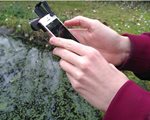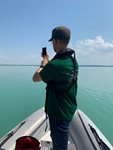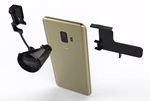Overview
Attach iSPEX 2 to any smartphone and gather data on spectropolarimetry by taking a picture of the water, the sky and a grey card for calibration. Since it is attached directly to your phone, iSPEX 2 does not need to enter the water and can be used from the shore or a boat. Data on the intensity and polarisation of light at different wavelengths (colours) is collected and analysed to provide information on the concentrations of certain materials in the water such as: chlorophyll-a, dissolved organic matter, and particulate matter.
Using a smartphone to gather environmental data allows everyone to become a scientist, massively expanding the amount of measurements that can be taken over time and area. As a low-cost sensor iSPEX 2 can easily be used to extend monitoring programmes into remote areas or at any time between official sampling runs.
Through the MONOCLE project the amount and quality of data collected via iSPEX2 has greatly improved through the development of an entirely new hardware design universal to almost every smartphone, and by data analysis now being based on the
SPECTACLE method (
Burggraaff et al 2019).
- Sensor measures the polarised intensity of light in two orthogonal directions (horizontal and vertical polarisation),
- Hyperspectrally from 390-700 nm at approx. 9 nm resolution (exact figures depending on the smartphone used).
From this data the unpolarised spectrum and angle of linear polarisation can be retrieved which is used to infer properties of the water.
Two slits, side by side, let through light from a single direction. This is modulated by a set of SPEX optics (λ/4 retarder, multi-order retarder, linear polarisers) that encode the polarisation information into the spectrum as light and dark bands. Finally, a grating disperses the light onto the smartphone camera, in the form of two rainbows (one per slit) with opposing light/dark bands. The smartphone camera registers these data and they are processed using
SPECTACLE.
c82e.jpg?maxsidesize=150)


c82e.png?maxsidesize=150)


Technical drawing

Technical diagram of the iSPEX 2 sensor
By citizen scientists on a smartphone, from the shore or a boat
We provide several interoperable data interfaces, as detailed below:
Smartphone camera metadata, pointing/GPS information: JSON metadata (refreshed every 5 minutes)
Raw spectropolarimetry images
Supporting materials
User guide: iSPEX 2: Deployment and Operation
Download the operational protocols for MONOCLE sensors and platforms
This document provides a set of protocols for
the deployment of MONOCLE systems to ensure best practices to collect reliable data.
System user and developer handbook This handbook provides an overview of the data requirements and interfaces that were adopted in the sensors and observation platforms of MONOCLE.
Standardized spectral and radiometric calibration of consumer cameras. Burggraaff O. et al. Optics Express, Vol 27, Issue 14, 2019.
A universal smartphone add-on for portable spectroscopy and polarimetry: iSPEX 2. Burggraaff O. et al. Proc. SPIE 11389, Micro- and Nanotechnology Sensors, Systems, and Applications XII, 2020.